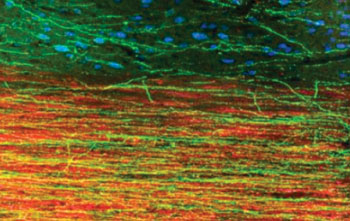Grafted Human Stem Cells Experience Drastic Growth in Spinal Cords of Rats
By LabMedica International staff writers
Posted on 19 Aug 2014
Scientists have reported that neurons derived from human induced pluripotent stem cells (iPSCs) and grafted into rats after a spinal cord injury produced cells with tens of thousands of axons extending virtually the entire length of the animals’ central nervous system (CNS).Posted on 19 Aug 2014
Drawing upon earlier studies, scientists from the University of California (UC), San Diego School of Medicine (USA) and Veteran’s Affairs San Diego Healthcare System reported that neurons derived from iPSCs and grafted into lab rats after a spinal cord injury generated cells with tens of thousands of axons extending virtually the entire length of the rodents’ CNS.

Image: Extension of human axons into host adult rat white matter and gray matter three months after spinal cord injury and transplantation of human induced pluripotent stem cell-derived neurons. Green fluorescent protein identifies human graft-derived axons, myelin (red) indicates host rat spinal cord white matter and blue marks host rat gray matter (Photo courtesy of UCSD – University of California, San Diego School of Medicine).
Writing in the August 7, 2014, early online edition of the journal Neuron, lead scientist Paul Lu, PhD, of the UC San Diego department of neurosciences and colleagues reported that the human iPSC-derived axons extended through the white matter of the injury sites, frequently penetrating adjacent gray matter to form synapses with rat neurons. Similarly, rat motor axons penetrated the human iPSC grafts to form their own synapses.
The iPSCs used were developed from a healthy 86-year-old human male. “These findings indicate that intrinsic neuronal mechanisms readily overcome the barriers created by a spinal cord injury to extend many axons over very long distances, and that these capabilities persist even in neurons reprogrammed from very aged human cells,” said senior author Mark Tuszynski, MD, PhD, professor of neurosciences and director of the UC San Diego Center for Neural Repair.
For several years, Dr. Tuszynski and colleagues have been steadily chipping away at the notion that a spinal cord injury necessarily results in permanent dysfunction and paralysis. Earlier work has shown that grafted stem cells reprogrammed to become neurons can, in fact, form new, functional circuits across an injury site, with the treated animals experiencing some restored capability to move affected limbs. The new findings emphasize the potential of iPSC-based therapy and suggest a range of new studies and problems to be solved, such as whether axons can be guided and how will they develop, function and mature over longer periods of time.
While neural stem cell therapies are already advancing to clinical trials, this research raises cautionary notes about moving to human therapy too quickly, according to Dr. Tuszynski. “The enormous outgrowth of axons to many regions of the spinal cord and even deeply into the brain raises questions of possible harmful side effects if axons are mistargeted. We also need to learn if the new connections formed by axons are stable over time, and if implanted human neural stem cells are maturing on a human time frame--months to years--or more rapidly. If maturity is reached on a human time frame, it could take months to years to observe functional benefits or problems in human clinical trials.”
In the latest research, Drs. Lu, Tuszynski and colleagues converted skin cells from a healthy 86-year-old man into iPSCs. The iPSCs were then reprogrammed to become neurons in collaboration with the laboratory of Larry Goldstein, PhD, director of the UC San Diego Sanford Stem Cell Clinical Center. The new human neurons were then embedded in a matrix containing growth factors and grafted into two-week-old spinal cord injuries in rats.
Three months later, researchers examined the post-transplantation injury sites. They found biomarkers indicating the presence of mature neurons and extensive axonal growth across long distances in the animals’ spinal cords, even extending into the brain. The axons traversed wound tissues to penetrate and connect with existing rat neurons. Correspondingly, rat neurons extended axons into the grafted material and cells. The transplants produced no identifiable tumors.
Even though numerous connections were formed between the implanted human cells and rat cells, functional recovery was not found. However, Dr. Lu noted that tests evaluated the rats’ skilled use of the hand. Simpler assays of leg movement could still show benefit. Moreover, several iPSC grafts contained scars that may have suppressed beneficial effects of new connections. Continuing research will help to optimize transplantation techniques to eliminate scar formation.
According to Dr. Tuszynski, he and his team are trying to identify the most promising neural stem cell type for repairing spinal cord injuries. They are examining iPSCs, embryonic stem cell-derived cells, and other stem cell types. “Ninety-five percent of human clinical trials fail. We are trying to do as much as we possibly can to identify the best way of translating neural stem cell therapies for spinal cord injury to patients. It’s easy to forge ahead with incomplete information, but the risk of doing so is greater likelihood of another failed clinical trial. We want to determine as best we can the optimal cell type and best method for human translation so that we can move ahead rationally and, with some luck, successfully.”
Related Links:
University of California, San Diego School of Medicine










 (3) (1).png)


